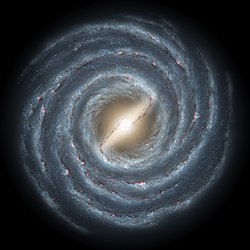Segue 1
| Galaxie Segue 1 | |
|---|---|
| AladinLite | |
| Sternbild | Löwe |
| Position Äquinoktium: J2000.0, Epoche: J2000.0 | |
| Rektaszension | 10h 07m 04s[1] |
| Deklination | 16° 04′ 55″ [1] |
| Erscheinungsbild | |
| Morphologischer Typ | dSph oder GC [2][1] |
| Helligkeit (B-Band) | 13,8 ± 0,5 mag [2] |
| Physikalische Daten | |
| Zugehörigkeit | Lokale Gruppe |
| Entfernung | 75.000 ± 6.500 Lj / 23.000 ± 2.000 pc [2] |
| Geschichte | |
| Katalogbezeichnungen | |
Segue 1 ist eine kleine Zwerggalaxie, die die Milchstraße umkreist, möglicherweise auch ein Kugelsternhaufen.
Obwohl Segue 1 nur wenige sichtbare Sterne besitzt, übt sie eine tausendmal stärkere Gravitation aus und hat damit eine tausendfach höhere Masse, als sie aufgrund ihrer Leuchtkraft vermuten ließe. Sie ist damit eines der extremsten Beispiele für eine Galaxie mit dunkler Materie.[3]
Bei der Galaxie handelt es sich um eine von zahlreichen beinahe unsichtbaren Galaxien, die bei der Sloan Digital Sky Survey entdeckt wurden. Diese Galaxien enthalten etwa 100- bis 1000-mal so viel dunkle Materie wie sichtbare Materie. Die Milchstraße enthält dagegen etwa zehnmal so viel dunkle Materie wie sichtbare Materie.[4]
Weiteres
- Segue 2
- Zwerggalaxie
- Lokale Gruppe
Einzelnachweise
- ↑ a b SIMBAD Astronomical Database. In: Results for NAME SEGUE 1. Abgerufen am 13. März 2010.
- ↑ a b c V. Belokurov, Zucker, D.B.; Evans, N.W. et al.: Cats and Dogs, Hair and a Hero: A Quintet of New Milky Way Companions. In: The Astrophysical Journal. 654, 2007, S. 897–906. arxiv:astro-ph/0608448. bibcode:2007ApJ...654..897B. doi:10.1086/509718.
- ↑ Nearby Galaxy Nearly Invisible, Space.com
- ↑ Astronomers Find a Galaxy Stuffed With Dark Matter. In: Discover Magazine Blogs, 19. September 2008. Abgerufen am 22. September 2008.
Auf dieser Seite verwendete Medien
Caption from NASA: Like early explorers mapping the continents of our globe, astronomers are busy charting the spiral structure of our galaxy, the Milky Way. Using infrared images from NASA's Spitzer Space Telescope, scientists have discovered that the Milky Way's elegant spiral structure is dominated by just two arms wrapping off the ends of a central bar of stars. Previously, our galaxy was thought to possess four major arms.
This artist's concept illustrates the new view of the Milky Way, along with other findings presented at the 212th American Astronomical Society meeting in St. Louis, Mo. The galaxy's two major arms (Scutum-Centaurus and Perseus) can be seen attached to the ends of a thick central bar, while the two now-demoted minor arms (Norma and Sagittarius) are less distinct and located between the major arms. The major arms consist of the highest densities of both young and old stars; the minor arms are primarily filled with gas and pockets of star-forming activity.
The artist's concept also includes a new spiral arm, called the "Far-3 kiloparsec arm," discovered via a radio-telescope survey of gas in the Milky Way. This arm is shorter than the two major arms and lies along the bar of the galaxy.
Our sun lies near a small, partial arm called the Orion Arm, or Orion Spur, located between the Sagittarius and Perseus arms.Autor/Urheber: Copyright © 2003 Torsten Bronger., Lizenz: CC BY-SA 3.0
This is a celestial map of the constellation Leo, the Lion.




